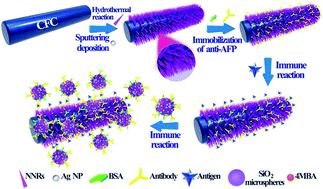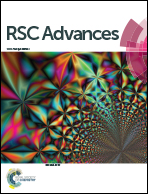SERS-based immunoassay using a core–shell SiO2@Ag immune probe and Ag-decorated NiCo2O4 nanorods immune substrate
Abstract
An immunoassay with high sensitivity based on surface enhanced Raman scattering (SERS) was realized by using a SiO2@Ag immune probe and Ag-decorated NiCo2O4 nanorods (NNRs) immune substrate. The SiO2@Ag immune probe was prepared by immobilizing Raman reporter molecules and anti-alpha fetoprotein (AFP) onto the SiO2@Ag hybrid structure. It was discovered that SiO2 colloidal microspheres attached with an appropriate amount of Ag nanoparticles (NPs) maintained the highest SERS intensity. Nanogaps between adjacent Ag NPs were proved to be the primary “hot spots” responsible for the significant Raman enhancement. Then, the immune substrate was synthesized by magnetron sputtering Ag NPs onto a NNRs coated carbon fiber cloth and linking them with anti-AFP. Such a novel substrate exhibited strong SERS activity and excellent reproducibility, due to the large amount of homogeneous Ag aggregates on the one-dimensional NNRs. Finally, a sandwich structure consisting of the SiO2@Ag immune probe and the Ag-decorated NNRs substrate was used to detect AFP and a detection limit as low as 2.1 fg mL−1 was obtained. It is imagined that the proposed strategy will show great advantages in sensitive immunoassays.

- This article is part of the themed collection: Surface enhanced Raman Spectroscopy: Editors collection for RSC Advances

 Please wait while we load your content...
Please wait while we load your content...